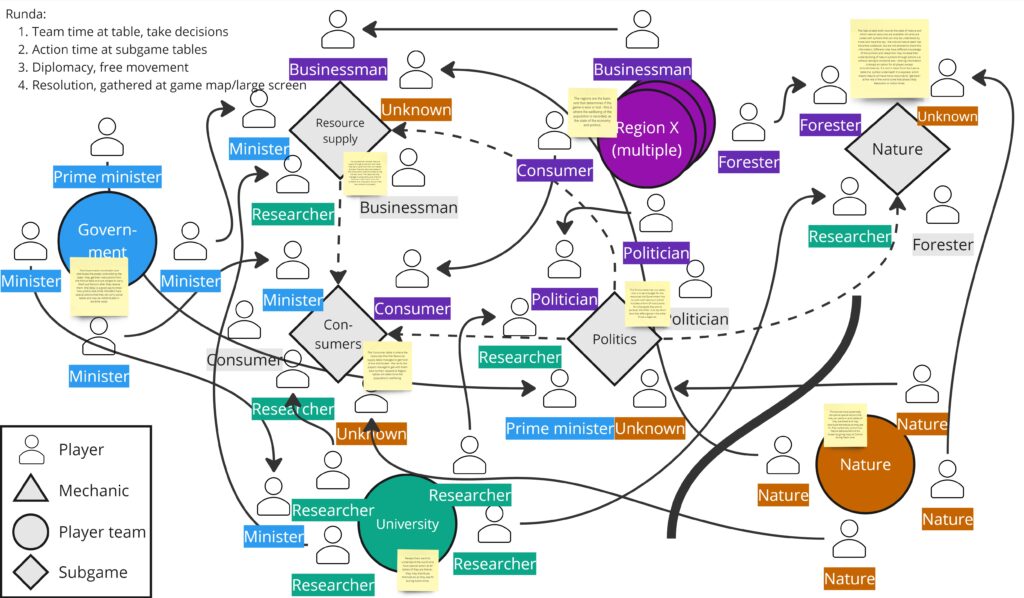After presenting the game concept I wrote about in my previous post to my project group yesterday, we had a very rewarding discussion which resulted in two things: their questions helped clarify (both to them and me) what the different parts of the game are meant to do, and their thoughts helped me gain a clearer picture of what kind of content I’m going to create and put into the subgames over the next two weeks.
As for the first part, it is hugely helpful to have people ask questions to understand the game concept drawing – and in this context, I’d like to add that even sentences that are at first not overtly recognisable as questions related to the game content are in fact just that: when someone is tyring to understand your game, they are often thinking very hard while at the same time trying to align their world view and the ideas about the project that they have established in their own minds with what they are seeing in front of them, which means that whatever the way they word it, they are in fact asking ‘how does this fit it with what I think I know?’, and this is the question I as a game designer try to answer. I find attempting to adopt this frame of mind very helpful to facilitate a productive feedback session that results in ideas for how to proceed rather than frustration about people not getting your point or trying to warp the game into something you think it can never become – at this point, the game barely has any outlines, so there’s not really any ‘forts to defend’ so to speak, so listening and answering the questions behind the statements is more productive.

As you can see in the image above, I made some changes to the concept drawing already at the meeting. This was due to the reaction to the word ‘Activist’, the discussion of which became so heated that it almost took over the entire feedback session, so I changed it to something that was less of an obstruction to the minds of the group. Also, based on the feedback I moved the Nature subgame from behind a screen and out in the open, instead placing the Nature team behind it to take their actions in secret, leaving the other players to wonder what they are all about during the first rounds, when the Nature players will be limited to saying one or a few words when communicating with other players, in addition to taking special actions at the subgames.
One piece of feedback regarding the idea that the Nature table will contain symbols that are intelligible to most players was that we today understand most things about nature, so there really are no secrets that only Nature players know: humans are largely aware of all the averse effects of their actions. After discussing it some more, we decided that although all the symbols may be known, the connections between them aren’t, meaning that the scientists (and some of the foresters) know what the symbols underneath the resource cards mean, but the exact effects of cutting down a forest area and converting a wetland area into farmland is not – that’s the game effect that the Nature players represent, i.e. the connections between actions and consequences. This will be explored in the game design process when I construct the Nature subgame.
The possibility of scientists interacting with Nature players to learn more about how things are connected was mentioned, and also that the work of researchers could quite literally be represented a puzzle. The role of the University/researchers/scientists in this particular game will have to be explored – it was included as I know from experience that the first things players do is ask if they can research new things, but just how this will work in the game is not yet clear, and it is entirely possible that research could be made into a mechanic instead of a table if it fits better with the narrative. At one point it was suggested that scientists play Nature, but that was later dropped, which shows just how unclear the role is at present – there is also the question if NGOs should have one or more tables in the game, or if they should replace the university as the knowledge-gathering/R&D aspect of the game.
One topic that was raised several times was how the issues between urban and rural areas/populations are expressed and dealt with during the game, and it was concluded that this will be dealt with in the subgames. At the resource supply/production table, the question of where resources should be sourced from may be one of those conflict areas: where to place wind power and nuclear plants, whether to use forest for production or recreation, how to develop businesses that are based in rural areas, etc. This is the part of the game where we will add most content after we have had interviews with stakeholders, and so the first playtests will mostly test various game mechanics to find out which work best.
Another aspect of the game that was raised was that of sustainability. My initial thoughts after listening in to the discussion is that economic sustainability is handled in the Resource supply and Consumer subgames, ecological/biological sustainability in the Resource supply and Nature subgames, and social sustainability in the Consumer and Politics subgames. What is considered to be sustainable remains to be discussed, and perhaps this is one thing that the game is about: negotiating a balance between the three instead of staring fixedly at economic sustainability and hoping technology will handle the rest? There is also the question of how to make visible how perspectives on sustainability vary between regions and urban/rural areas, which is particularly interesting in this project, and which I will keep in mind when I go to work on creating the first prototype of the game.
